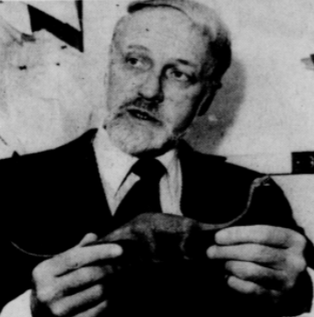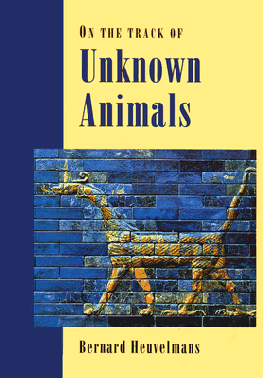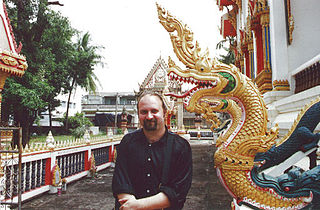Related Research Articles
Cryptozoology is a pseudoscience and subculture that searches for and studies unknown, legendary, or extinct animals whose present existence is disputed or unsubstantiated, particularly those popular in folklore, such as Bigfoot, the Loch Ness Monster, Yeti, the chupacabra, the Jersey Devil, or the Mokele-mbembe. Cryptozoologists refer to these entities as cryptids, a term coined by the subculture. Because it does not follow the scientific method, cryptozoology is considered a pseudoscience by mainstream science: it is neither a branch of zoology nor of folklore studies. It was originally founded in the 1950s by zoologists Bernard Heuvelmans and Ivan T. Sanderson.

The Loch Ness Monster, affectionately known as Nessie, is a creature in Scottish folklore that is said to inhabit Loch Ness in the Scottish Highlands. It is often described as large, long-necked, and with one or more humps protruding from the water. Popular interest and belief in the creature has varied since it was brought to worldwide attention in 1933. Evidence of its existence is anecdotal with a number of disputed photographs and sonar readings.

Mokele-mbembe, Lingala for "one who stops the flow of rivers", is a mythical water-dwelling entity that supposedly lives in the Congo River Basin, sometimes described as a living creature, sometimes as a spirit. Descriptions vary widely among those who claim to have seen the creature, but it is often described as a large quadrupedal herbivore with smooth skin, a long neck and a single tooth or horn.

A lake monster is a lake-dwelling entity in folklore. The most famous example is the Loch Ness Monster. Depictions of lake monsters are often similar to those of sea monsters.
Loren Coleman is an American cryptozoologist who has written over 40 books on a number of topics, including the pseudoscience and subculture of cryptozoology.

Jon-Erik Beckjord was an American paranormal investigator, photographer, and cryptozoologist interested in such phenomena as UFOs, crop circles, the Loch Ness Monster, and Bigfoot. Throughout his career, he owned three separate, small-scale museums that featured displays, mostly photographs, of alleged UFO, Nessie, and Bigfoot sightings. He made guest appearances on national radio and television shows, but was criticized by fellow cryptozoologists and skeptics alike for not providing substantive evidence to back up his claims of the existence of paranormal beings.

Nicholas Redfern is a British best-selling author, journalist, cryptozoologist and ufologist.

Roy P. Mackal was a University of Chicago biologist best known to the general public for his interest in cryptozoology.

Benjamin Radford is an American writer, investigator, and skeptic. He has authored, coauthored or contributed to over twenty books and written over a thousand articles and columns on a wide variety of topics including urban legends, unexplained mysteries, the paranormal, critical thinking, mass hysteria, and media literacy. His book, Mysterious New Mexico: Miracles, Magic, and Monsters in the Land of Enchantment, was published in the summer of 2014 and is a scientific investigation of famous legends and folklore in the state of New Mexico. In 2016 Radford published Bad Clowns, a 2017 IPPY bronze award winner, and he is regarded as an expert on the bad clowns phenomenon.

On the Track of Unknown Animals is a cryptozoological book by the Belgian-French zoologist Bernard Heuvelmans that was first published in 1955 under the title Sur la Piste des Bêtes Ignorées. The English translation by Richard Garnett was published in 1958 with some updating by the author and with a foreword by Gerald Durrell. A revised and abridged edition was published in 1965, and a further edition in 1995. It is credited with introducing the term cryptozoology and established its author as the "Father of Cryptozoology."

Richard Freeman is a cryptozoologist, author, zoological journalist, and WebTV Presenter. He is also the zoological director of the Centre for Fortean Zoology (CFZ), and co-edits both the journal, Animals & Men and several editions of the annual CFZ Yearbook. Freeman has written, co-written, or edited a number of books, and has contributed widely to both Fortean and zoological magazines, as well as other newspapers and periodicals, including Fortean Times and Paranormal Magazine.
Lake Khaiyr is a remote volcanic lake situated in the Yakutia region of eastern Siberia. Its surface area is approximately 72 acres (29 ha) and it has few fish. Its depth is yet unknown. It is called "Khaiyr" due to the Mongol influence in the region. Lake is located about five kilometres (3.1 mi) to the south from settlement with the same name Khayyr.

MonsterQuest is an American television series that originally aired from October 31, 2007 to March 24, 2010 on the History channel. Produced by Whitewolf Entertainment, the program deals with the search for various monsters of interest to the cryptozoology subculture and paranormal entities reportedly witnessed around the world. A spin-off show, MysteryQuest, which focuses on unsolved mysteries, premiered on September 16, 2009.

Boris Fyodorovich Porshnev was a Soviet historian known for his works on popular revolts in Ancien Régime France and a doctor of social sciences working on psychology, prehistory, and neurolinguistics as relating to the origins of man.

MonsterTalk is an audio podcast originally presented by the Skeptics Society's Skeptic magazine but broke ties in 2019. Since 2019 it has been an independent podcast under the "Monster House, LLC" banner. The show critically examines the science behind cryptozoological creatures, such as Bigfoot, the Loch Ness Monster, and werewolves. It is hosted by Blake Smith and Karen Stollznow, and produced by Blake Smith. In 2012, MonsterTalk was awarded the Parsec Award for the "Best Fact Behind the Fiction Podcast".
Ken Gerhard is an American cryptozoologist and author often featured on various television programs. His works include "The Essential Guide to Bigfoot," "A Menagerie of Mysterious Beasts," "Big Bird: Modern Sightings of Flying Monsters" and "Encounters with Flying Humanoids: Mothman, Manbirds, Gargoyles and Other Winged Beasts." He is also the co-author of "Monsters of Texas".

Ivan Mackerle was a Czech cryptozoologist, author, design engineer, and explorer. He organized expeditions to search for the Loch Ness monster of Scotland, the Tasmanian tiger in Australia, and the elephant bird in Madagascar. He was most notable for his search of the Mongolian death worm, and he conducted three trips to Mongolia in 1990, 1992, and 2004. He authored numerous books and publications and from 1998 until 2002 he was chief editor of the Czech paranormal magazine Fantastická fakta.
Tracking the Chupacabra: The Vampire Beast in Fact, Fiction and Folklore is a non-fiction book by Benjamin Radford, an American writer and investigator. The book documents Radford's five-year investigation into accounts of the chupacabra. The chupacabra is said to be a vampiric predatory animal that drains the blood of animal victims while avoiding human detection.
References
- ↑ Shuker, Karl. "Dr. Karl P.N. Shuker: Biography" . Retrieved 16 February 2013.
- 1 2 Newton, Michael, 2005, Encyclopedia of Cryptozoology: A Global Guide (McFarland & Co, Inc: Jefferson), p. 425: "Today, he [Shuker] is globally recognized as an author and researcher on all aspects of animal life and unexplained phenomena, the heir apparent to Heuvelmans himself."
- 1 2 Coleman, Loren; Clark, Jerome (5 August 1999). Cryptozoology A To Z: The Encyclopedia of Loch Monsters Sasquatch Chupacabras And Other Authentic Mysteries of Nature . Simon and Schuster. p. 221. ISBN 978-0-684-85602-5.
- 1 2 3 Shuker, Karl. "Dr. Karl Shuker – Zoologist, Cryptozoologist, Author" . Retrieved 18 February 2013.
- ↑ Downes, Jonathan; Shuker, Karl (2007). "Forward". Extraordinary Animals Revisited. Bideford: CFZ Press.
- 1 2 3 4 "Beyond Bigfoot: the science of cryptozoology". Mongabay.com. 26 March 2012.
- 1 2 Østli, Hanne Jakobsen (22 January 2013). "Kryptozoologene forsøker igjen" (in Norwegian). Forskning.no.
- ↑ Cossins, Dan (February 2013). "Monster Hunting 2.0". The Scientist . Archived from the original on 12 May 2013.(subscription required)
- ↑ Shuker, Karl P. N. (1 November 2003). The Beasts that Hide from Man: Seeking the World's Last Undiscovered Animals. Paraview Press. ISBN 1931044643.
- 1 2 Radford, Ben (15 March 2011). Tracking the Chupacabra: The Vampire Beast in Fact, Fiction, and Folklore. University of New Mexico Press. pp. 5, 8, 17. ISBN 978-0826350152.
- 1 2 Ellis, Richard (February 1996). "Dragons are us". Natural History. Vol. 105, no. 2. p. 12. ISSN 0028-0712.(subscription required)
- ↑ Tredre, Roger (8 June 1997). "Bad news for Mulder, UFO expert says mystery is bunk". The Observer. London (UK), United Kingdom. p. 020. ISSN 0029-7712.
- ↑ Brown, Allan (18 January 1998). "Shock-Ness". Sunday Times. London (UK), United Kingdom. pp. Ecosse 1. ISSN 0956-1382.
- ↑ Bayless, Mark K. (September 2005). "Review: The Beasts that Hide from Man: Seeking the World's Last Undiscovered Animals by Karl P N Shuker; Cryptozoology: Science & Speculation by Chad Arment; Encyclopedia of Cryptozoology: A Global Guide to Hidden Animals and Their Pursuers by Michael Newton". The Quarterly Review of Biology . 80 (3): 367. doi:10.1086/497226.
- ↑ Eseves, Bernardo (March 2013). "Ciência dos seres imaginários ("Science of Imaginary Beings")". Revista Piauí (in Portuguese) (78). Archived from the original on 12 March 2013.
- ↑ Heiner, Iben; Kristensen, Reinhardt Møbjerg (2005). "Two new species of the genus Pliciloricus (Loricifera, Pliciloricidae) from the Faroe Bank, North Atlantic". Zoologischer Anzeiger. 243 (3): 121–138. doi:10.1016/j.jcz.2004.05.002.
- ↑ Tarrant, Chris (2008). Millionaire Moments: The Story of 'Who Wants to Be a Millionaire'. Little, Brown Book Group. ISBN 978-0-7481-0911-1.